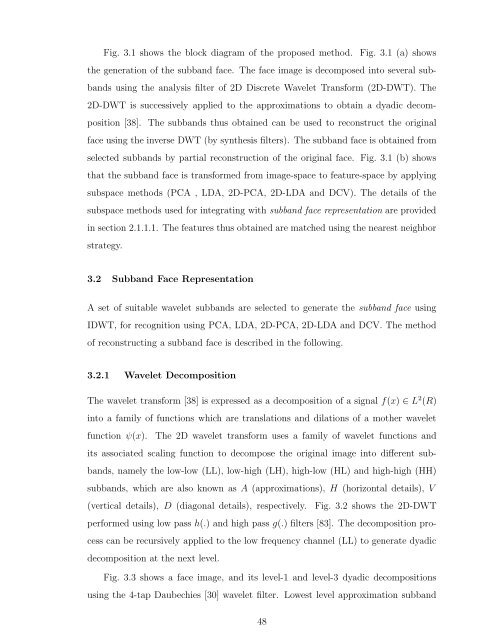Master Thesis - Department of Computer Science
Master Thesis - Department of Computer Science
Master Thesis - Department of Computer Science
Create successful ePaper yourself
Turn your PDF publications into a flip-book with our unique Google optimized e-Paper software.
Fig. 3.1 shows the block diagram <strong>of</strong> the proposed method. Fig. 3.1 (a) shows<br />
the generation <strong>of</strong> the subband face. The face image is decomposed into several sub-<br />
bands using the analysis filter <strong>of</strong> 2D Discrete Wavelet Transform (2D-DWT). The<br />
2D-DWT is successively applied to the approximations to obtain a dyadic decom-<br />
position [38]. The subbands thus obtained can be used to reconstruct the original<br />
face using the inverse DWT (by synthesis filters). The subband face is obtained from<br />
selected subbands by partial reconstruction <strong>of</strong> the original face. Fig. 3.1 (b) shows<br />
that the subband face is transformed from image-space to feature-space by applying<br />
subspace methods (PCA , LDA, 2D-PCA, 2D-LDA and DCV). The details <strong>of</strong> the<br />
subspace methods used for integrating with subband face representation are provided<br />
in section 2.1.1.1. The features thus obtained are matched using the nearest neighbor<br />
strategy.<br />
3.2 Subband Face Representation<br />
A set <strong>of</strong> suitable wavelet subbands are selected to generate the subband face using<br />
IDWT, for recognition using PCA, LDA, 2D-PCA, 2D-LDA and DCV. The method<br />
<strong>of</strong> reconstructing a subband face is described in the following.<br />
3.2.1 Wavelet Decomposition<br />
The wavelet transform [38] is expressed as a decomposition <strong>of</strong> a signal f(x) ∈ L 2 (R)<br />
into a family <strong>of</strong> functions which are translations and dilations <strong>of</strong> a mother wavelet<br />
function ψ(x). The 2D wavelet transform uses a family <strong>of</strong> wavelet functions and<br />
its associated scaling function to decompose the original image into different sub-<br />
bands, namely the low-low (LL), low-high (LH), high-low (HL) and high-high (HH)<br />
subbands, which are also known as A (approximations), H (horizontal details), V<br />
(vertical details), D (diagonal details), respectively. Fig. 3.2 shows the 2D-DWT<br />
performed using low pass h(.) and high pass g(.) filters [83]. The decomposition pro-<br />
cess can be recursively applied to the low frequency channel (LL) to generate dyadic<br />
decomposition at the next level.<br />
Fig. 3.3 shows a face image, and its level-1 and level-3 dyadic decompositions<br />
using the 4-tap Daubechies [30] wavelet filter. Lowest level approximation subband<br />
48










